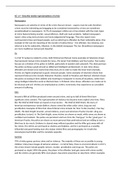AC 1.4 - Describe media representations of crime
Newspapers
Newspapers are selective in terms of the crime that are shown – papers must be sold, therefore
crimes must be interesting and engaging to be considered newsworthy; crimes are sometimes
sensationalised in newspapers. 12.7% of newspaper articles are crime related, with the main types
of crime featured being murder, sexual offences, theft and road accidents. Tabloid newspapers
report crime using more pictures and more judgemental language. They also report more
controversial crimes and target people, such as referring to offenders by their nationality alone. One
example of this was the reporting of the murder of Sabina Nessa – the offender, Koci Selamaj, was
referred to by his nationality, Albanian, in the tabloid newspaper The Sun. Broadsheet newspapers
are more traditional, factual and impartial.
TV
¼ of all TV output is related to crime, both fictional and factual. Some examples of television shows
that represent factual crime include the news, The Great Train Robbery and Fast Justice. Fast Justice
focuses on a division of the police in Suffolk, particularly in Ipswich and Lowestoft. The show portrays
the police as doing a good job and as skilled and intelligent professionals. In real crime shows,
offenders are shown to be worse than they truly are in order to make the show more dramatic.
Victims are highly emphasised as good, innocent people. Some examples of television shows that
represent fictional crime include Midsomer Murders, Death in Paradise and Sherlock. Sherlock shows
the police as lacking in their abilities and resorting to manpower in nearly all situations, rather than
using intelligent detective work as Sherlock does. In fictional crime shows, offenders are made out to
be inhuman and evil. Victims are emphasised as victims. Commonly, they experience an unrealistic
amount of suffering.
Film
Around a fifth of all films produced centre around crime, and up to half of these films have
significant crime content. The representation of violence has become more explicit over time. Films
like The Wolf of Wall Street are based on true stories – The Wolf of Wall Street, the story of
American entrepreneur Jordan Belfort, shows crimes like white collar crime, drug use and
prostitution. Examples of films that show fictional crime include No Time To Die (murder), Free Guy
(theft), The Dark Knight (murder, armed robbery, arson) and American Psycho (murder, drug use,
prostitution, torture). In The Dark Knight, some victims are shown as weak, while some are shown as
confident and resilient. The police are persistent and turn from the “bad guys” to the “good guys”. In
American Psycho, the police are shown as more personal than professional and are willing to turn a
blind eye to too much. Evidence is cleared away without question and the killer gets away with all
his crimes. His victims are portrayed as clueless and helpless, and he is portrayed as a wealthy,
influential and good-looking man who enjoys violent films and pornography; he is both the
stereotypical serial killer and the complete opposite.
Gaming
70% of video games portray crime and/or violence. The majority of these are accessible to young
children. Many have images of extreme violence – in Call of Duty, there is a terrorist attack. In GTA V,
the crimes shown include graphic torture, murder, prostitution and drug use. The police are
portrayed as stupid. With this game, the player is the offender (and gets away with crimes easily),
and the victims are generally NPCs (non-player characters) powerless to stop them. Other examples




